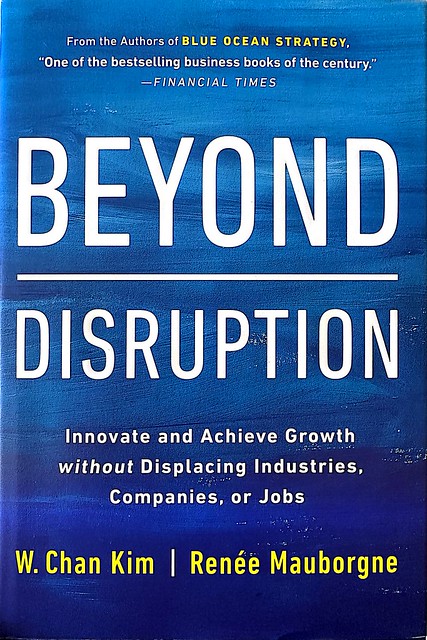3 minutes estimated reading time
Beyond Disruption by W Chan Kim and Renée Mauborgne moves their focus from general business strategy in their book Blue Ocean Strategy. You can read my review of Blue Ocean Strategy which I originally read a number of years ago. By contrast this book looks at the idea of non-disruptive innovation. Non-disruptive innovation as a topic makes sense within the blue ocean / red ocean model.
Success has its own challenges.
Kim and Mauborgne face a Augean literary challenge. Blue Ocean Strategy was so successful at the time, that any subsequent book will look diminished in its success by comparison. Blue Ocean Strategy had something for everyone. To marketers it spoke of differentiation and salience, for business management types it was about differentiation and innovation. Beyond Disruption delves deeper into the nature of that innovation in a way that Blue Ocean Strategy didn’t.
In Beyond Disruption the authors posit that their blue ocean strategy approach was a blend of disruptive and non-disruptive growth.
Difficult narratives
Disruptive innovation by its very nature means destruction of existing businesses as a new one is created. A classic example of this would be the battles between regulators and taxi drivers with Uber, or city governments looking to protect the needs of their citizens from AirBnB. The ideas of Joseph A. Schumpeter fit in with the innovation stories coming out of Silicon Valley. Apple and Google didn’t invent the smartphone, but they came up with a design that captured larger scale consumer interest than Nokia devices and captured the market.
It is the predominant narrative in the media and business community at the moment around innovation. Disruptive innovation fits in with the conflict driven narrative of business. It is reinforced by adaption of military thinking in a literal manner to business strategy. The authors themselves point out about how much business decision-making is driven by aggression and fear.
Approach of Beyond Disruption
The approach of Kim & Mauborgne to ‘nondisruptive creation’ in Beyond Disruption is broken into two parts which cover
- What it is and why it matters.
- How to realise nondisruptive creation.
What it is and why it matters
Kim and Mauborgne focus a lot of time in the first part of the book explaining the economic and social impact of non-disruptive creation. The idea is that creating new markets doesn’t destroy existing marketplaces. In theory, value will be created on top of the existing economic order, rather than being substitutive in nature.That narrative is largely true, but there are exceptions to bear in mind.
If we think about the smartphone as a device category, even prior to Apple and Google displacing Nokia, cell phones were displacing existing categories. Sales of answerphones dropped, as did the sales of chocolate to children and the incidence of children smoking. Instead the pocket money was spent on handsets and PAYG (pay as you go) mobile tariffs.
Beyond Disruption outlines four sources of business advantage to non-disruptive creation:
- Avoiding direct confrontations with established incumbents.
- An effective way to respond to full-on disruption.
- Support from internal stakeholders who will view non-disruptive innovation as less emotionally charged.
- No evident backlash from external stakeholders.
The authors see this approach as a way to address the challenges of ESG and the fourth industrial age of automation.
How to realise non-disruptive creation
The authors start with the idea of the right perspective. This involves:
- Leaders moving away from the ‘startup story’ of an innovative founder or co-founder. Instead the problem to be solved needs to be recognised first.
- Don’t confuse the means with the end.
- Focus on the many, not the few. Have a product that is likely to be adopted by a range of customers.
Identifying opportunities is considered in a separate section, the key point of which was the idea of empathetically observing newly emerging or unexplored problems. These ideas can then be explored further by understanding the scale of the challenge (amount of people affected etc) and understand the assumptions others have made that persuaded them to avoid the opportunity.
In conclusion
With Beyond Disruption, Kim and Mauborgne are looking to encourage a business more in keeping with the needs of stakeholder capitalism. More on Beyond Disruption here.
